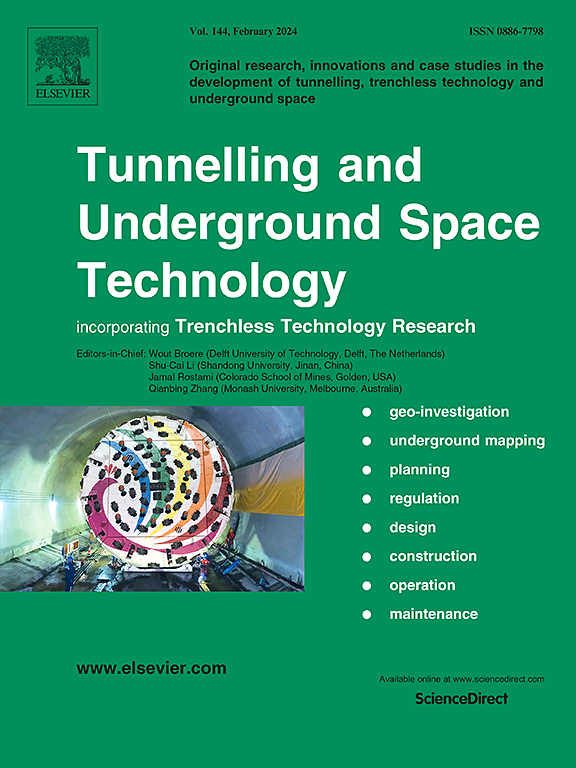Face stability analysis of a submerged shield tunnel driven in inclined layered soils
IF 7.4
1区 工程技术
Q1 CONSTRUCTION & BUILDING TECHNOLOGY
引用次数: 0
Abstract
The excavation of submerged shield tunnels in saturated inclined layered soils is commonly encountered in engineering practice. However, previous studies have primarily focused on the tunnel face stability in saturated horizontal layered soils. Additionally, the existing approaches for calculating the seepage flow field have limitations in terms of accuracy or efficiency. To address these issues, a modified approach is proposed to evaluate the face stability of a circular shield tunnel driven in saturated inclined layered soils, enabling the assessment of face stability at various excavation locations. The distribution of pore water pressure is derived from a customized FEM solver and incorporated with the discretization-based rotational failure mechanism. Additionally, the validation of the rotational failure mechanism in saturated inclined layered soils is performed through numerical results, along with comparisons of the critical collapse pressure against previous theoretical results. The effects of soil interface position and attitude on tunnel face stability are further investigated. It is revealed that: (1) the proposed approach is highly effective in accurately estimating the critical collapse pressure at various tunneling positions for a submerged shield tunnel driven in saturated inclined layered soils; (2) the customized FEM solver significantly enhances computational efficiency and accuracy compared to previous theoretical approaches. Additionally, it requires significantly lower computational costs than the commercial FEM solver; (3) the critical collapse pressure decreases nonlinearly and then increases slowly with a gradually extended critical failure mechanism when a tunnel traverses an inclined soil interface for the upper cohesive and lower sandy soil layers.
倾斜层状土中盾构隧道开挖工作面稳定性分析
饱和倾斜层状土中淹没盾构隧道的开挖是工程实践中经常遇到的问题。然而,以往的研究主要集中在饱和水平层状土中隧道工作面稳定性。此外,现有的渗流场计算方法在精度和效率方面存在局限性。针对这些问题,提出了一种改进的饱和倾斜层状土中圆形盾构隧道工作面稳定性评价方法,实现了对不同开挖位置工作面稳定性的评价。孔隙水压力分布由定制的有限元求解器导出,并结合基于离散化的旋转破坏机制。此外,通过数值结果验证了饱和倾斜层状土的旋转破坏机制,并将临界坍塌压力与先前的理论结果进行了比较。进一步研究了土体界面位置和姿态对巷道工作面稳定性的影响。结果表明:(1)该方法能够准确估计饱和倾斜层状土中盾构隧道各掘进位置的临界坍塌压力;(2)与以往的理论方法相比,定制化有限元求解器显著提高了计算效率和精度。此外,与商用有限元求解器相比,它所需的计算成本显着降低;(3)当隧道穿越上黏结层和下沙土层的倾斜土界面时,隧道的临界破坏压力呈先非线性减小后缓慢增大的趋势,其临界破坏机制逐渐扩展。
本文章由计算机程序翻译,如有差异,请以英文原文为准。
求助全文
约1分钟内获得全文
求助全文
来源期刊

Tunnelling and Underground Space Technology
工程技术-工程:土木
CiteScore
11.90
自引率
18.80%
发文量
454
审稿时长
10.8 months
期刊介绍:
Tunnelling and Underground Space Technology is an international journal which publishes authoritative articles encompassing the development of innovative uses of underground space and the results of high quality research into improved, more cost-effective techniques for the planning, geo-investigation, design, construction, operation and maintenance of underground and earth-sheltered structures. The journal provides an effective vehicle for the improved worldwide exchange of information on developments in underground technology - and the experience gained from its use - and is strongly committed to publishing papers on the interdisciplinary aspects of creating, planning, and regulating underground space.
 求助内容:
求助内容: 应助结果提醒方式:
应助结果提醒方式:


